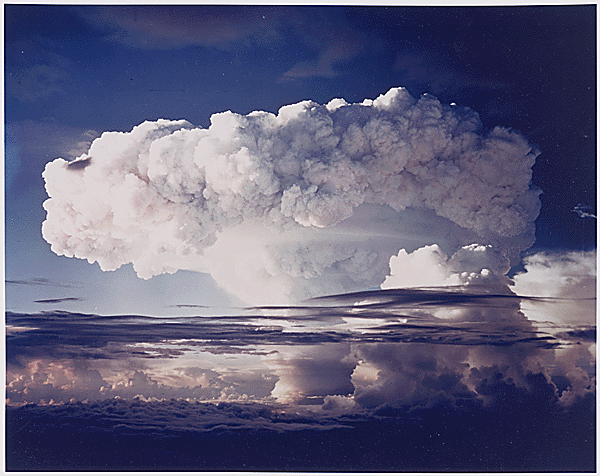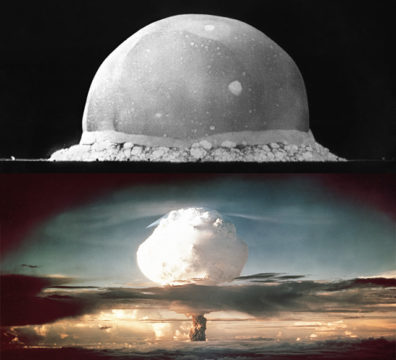The Democratic People’s Republic of Korea (DPRK) announced it detonated its first hydrogen bomb on Tuesday, though many experts believe that based on the magnitude of blast, it was likely less than a typical hydrogen bomb, or even an atomic bomb. So what exactly is the difference between an atomic bomb and a hydrogen bomb? Find out here:
ATOMIC BOMB:
Nuclear weapons have been around ever since the United States became the first nation to test the atomic bomb in 1945.
A traditional atomic bomb uses fission, meaning it splits the nuclei of atoms in a material such as uranium. The particles released from the split continue to hit other atoms and split those, leading to a chain reaction, according to the California Energy Commission.
Such a chain reaction can cause a huge explosion. The first atomic bomb used in warfare in Hiroshima, Japan in 1945 had a blast yield of 15 kilotons of TNT, for example.

Images of the first nuclear weapon test, known as the “Trinity Test” developed in the Manhattan Project at the Los Alamos National Laboratory. The test took place on July 16, 1945 in the desert more than 200 miles south of Los Alamos, New Mexico. (Photos by the U.S. Dept. of Energy)
The estimated blast yield of recent DPRK detonation was 6 kilotons and a quake magnitude of 4.8 (4.9 as measured by the China Earthquake Network Center and 5.1 as measured by the United States), said South Korean lawmaker Lee Cheol Woo to the Associated Press, after being briefed by South Korea’s National Intelligence Service.
HYDROGEN BOMB:
A hydrogen bomb uses the traditional fission of an atomic bomb to ignite a larger explosion that then causes smaller nuclei of atoms to get close enough to fuse together to make a larger one. The sun is a natural fusion reactor that gives off heat and light.
A hydrogen bomb can be hundreds of times more powerful than atomic bombs. The first hydrogen bomb was tested by the United States on an island in the Pacific Ocean in 1954, and had a blast 500 times that of previous atomic bombs, with a yield of 10,400 kilotons of TNT, according to the Los Alamos National Laboratory.
The test “completely vaporized the small island it was conducted on” the laboratory reported.

The world’s first hydrogen bomb, codenamed “Ivy Mike”, was tested on Oct. 31, 1952 at Enewetak Atoll in the Pacific Ocean. (Photo by: U.S. Department of Energy)
Speaking to CCTV, military expert Du Wenlong said that given the magnitude, the recent test falls short of a normal hydrogen bomb.
The only way this could have been a hydrogen bomb was if the DPRK acquired the capacity of devising smaller hydrogen bombs, something that isn’t easy to do, he said.
Speaking to the Associated Press Melissa Hanham, senior researcher at the James Martin Center for Nonproliferation Studies at the Middlebury Institute for International Studies in Monterey, California, said that she was skeptical it was a hydrogen test.
“The seismic data indicates it would be very small for a hydrogen test… It seems just too soon to have this big technical achievement,” she said.
Jaiki Lee, a professor of nuclear engineering at Seoul’s Hanyang University, said the DPRK could have experimented with a “boosted” hybrid bomb, the AP also reported.
CCTV AMERICA’S COVERAGE OF DPRK TEST:

Story by CCTV America with information from the Associated Press and CCTV.
 CGTN America
CGTN America
 An atomic bomb (top) and a hydrogen bomb (bottom). (Photos: Los Alamos National Laboratory)
An atomic bomb (top) and a hydrogen bomb (bottom). (Photos: Los Alamos National Laboratory)
